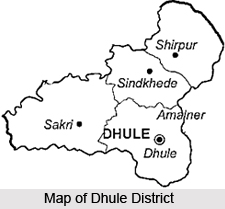 Administration of Dhule district is carried out by the district collector. He plays a rather important role in the administration of the district. Not only is he at the head of the Revenue Department in the district, but, in so far as the needs and exigencies of district administration are concerned, he is expected to supervise the working of the officers of other departments as well. Broadly speaking, his functions include matters relating to Revenue, Public Utility, Accounts, Quasi-Judicial junctions in revenue matters, Local Self-Government, Officers of Other Departments, role as District Magistrate and District Registrar, Sanitation and Public Health, District Soldiers`, Sailors` and Airmen`s Board and Control of essential articles.
Administration of Dhule district is carried out by the district collector. He plays a rather important role in the administration of the district. Not only is he at the head of the Revenue Department in the district, but, in so far as the needs and exigencies of district administration are concerned, he is expected to supervise the working of the officers of other departments as well. Broadly speaking, his functions include matters relating to Revenue, Public Utility, Accounts, Quasi-Judicial junctions in revenue matters, Local Self-Government, Officers of Other Departments, role as District Magistrate and District Registrar, Sanitation and Public Health, District Soldiers`, Sailors` and Airmen`s Board and Control of essential articles.
Prant Officers
Under the Collector are the Prant Officers who are either Assistant Collectors (Indian Administrative Service Officers) or District Deputy Collectors (Members of the Maharashtra Civil Service). There are two prants, viz. Dhulia and Nandurbar in the district. In addition to two Prant Officers there is one Resident Deputy Collector. The Prant Officers form the connecting link between Mamlatdars or Mahalkaris and the Collector. A Prant Officer exercises all the powers conferred on the Collector by the Land Revenue Code and by any other law in force or by executive orders, in regard to the talukas and mahals in his charge, except such powers as the Collector may specially reserve to himself. Mamlatdars and Mahalkari. The Mamlatdar is the officer in executive charge of a taluka and the Mahalkari has executive charge of a mahal. There is practically no difference between the functions and duties of a Mamlatdar and those of a Mahalkari. Each taluka or mahal has two or three Aval Karkuns, 8 or 10 Clerks, 50 Talathis, two Circle Officers and three Circle Inspectors. The duties of Mamlatdars and Mahalkaris fall under various heads. They include functions relating to revenue, quasi judicial and magisterial matters, treasury and accounts and other administrative duties.
Circle Officers and Circle Inspectors
In order to assist the Mamlatdar in exercising proper supervision over the village officers and village servants, Circle Officers and Circle.. Inspectors are appointed. There are about 30 to 50 villages in charge of a Circle Officer or a Circle Inspector. They form a link-between the Mamlatdar and the village officers. There are generally two Circle Officers and three Circle Inspectors in each taluka. Their duties relate to-
(1) Boundary marks inspection, inspection of crops including the estimating of the annewari, inspection of tagai works and detection of illegal occupation of Government land;
(2) Preparation of agricultural and other statistical returns, viz., crop statistics,` cattle census, and water supply;
(3) Supervision of the village officers in the preparation and maintenance of the Record of Rights, the mutation register and the tenancy register;
(4) Examination of land revenue receipts and supervision of revenue collection; and,
(5) Such other miscellaneous work as the Mamlatdar may, from time to time, entrust them with, e.g., enquiry into alleged encroachments, etc.
Patils
The Patil or village headman is the principal village official. Prior to 1st January 1963, there were revenue and police Patils functioning in the villages. These posts were, however, abolished from that date and stipendiary police Patils were appointed instead. These Patils perform the police duties prescribed in the Bombay Village Police Act, 1867.
Talathis
By the enactment of the Bombay Paragana and Kulkarni Watans Abolition Act all the Kulkarni watans along with the right of service were abolished from May 1st 1961 and Talathis were appointed in place of these Kulkarnis. If the villages are small one Talathi is appointed for two or more villages, which are called his charge. His main duties are: (1) to maintain the village accounts relating to demand, collection and arrears of land revenue etc., the Records of Rights and all other village forms prescribed by Government; (2) to inspect crop and boundary marks and to prepare agricultural statistics; and (3) to help the Patil in collection of land revenue, write the combined day and receipt books and other accounts and do other clerical work. The talathi functions as the Assistant Gram Sevak where community development projects or National Extension Service Blocks have been opened.
Kotwals
In addition to the village officers mentioned above, there are village servants or Kotwals. They are of two kinds, viz., (1) those useful to the community, and (2) those useful to the Government.They are appointed on fixed remuneration.
They assist the village officers to collect land revenue, summon villagers to chavdi, carry the land revenue to taluka office, help the Patil in the detection of offences and apprehension of known criminals. They also assist the Patil in the maintenance of law and order in the village. Thus discussed is the administrative structure of the district of Dhule.






